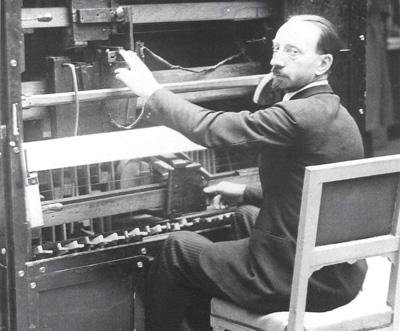People
Luigi Russolo Exhibition at Mart, Italy
An exhibition announced as the “first large-scale anthological of [Luigi] Russolo” is something that a Futurism fanatic and Russolo worshipper like me can’t miss.
Moreover, the info page at Mart‘s web site said:
Reconstructions of his “Noisemakers” […] will be put on show for the express purpose of enabling the public to interact with them.
I thought: “Wow! That’s great!” So last Sunday I woke up early in the morning and took a train to Rovereto, where the Mart (Museo d’arte moderna e contemporanea di Trento e Rovereto) is located.
Once arrived at the Mart guess which room I went first? You guessed right! The one devoted to the intonarumori.

So I enter the room and see a museum watch lady busy turning the crank of one of the many intonarumori for the benefit of a young couple that looks a little perplexed. I get near and ask the lady if I can play the intonarumori by myself and she says “No, I’m sorry. It’s forbidden”. I tell her what I’ve read about “the public interacting” with the intonarumori and she says “Yes, in the first days of the exhibition it was possible but some visitors played the instruments too rudely and they all got broken except three. But I can play them for you.”
I’ve been tempted to tell her that if all the gentle watch ladies of the museum had watched how people interacted with the intonarumori maybe things could have been different. But after all, it was not her fault. It’s the management of the museum that should have imagined that the exhibition could be visited also by some idiots.
I wonder if it will be possible to repair the intonarumori before they leave for the London exhibition.
So, after trying to instruct the lady on how to play the intonarumori for me in order to understand some things I have always wondered about them, I gave up and proceeded to look at the paintings. And in this respect, the exhibition is certainly worth visiting. There are many works by Russolo such as the famous “Music” (1911), “The revolt” (1911), “Impressions of Bombardment (Shrapnels and Grenades)” (1926), various self-portraits and many others. And there are also some works by the artists who were closest to him: Gaetano Previati, Umberto Boccioni, Carlo Carrà, Gino Severini, Romolo Romani, and Ugo Piatti, which was Russolo’s assistant.

There were also three silent movies by Eugène Deslaw, the musical accompaniments of which were played live on the Russolophone by Russolo himself during the projections at the Studio 28 theater in Paris. The movies are La marche des machines (there are documents that prove that Russolo played during the projections of this movie while for the others two there is no certainty), Les nuits electriques and Montparnasse, edited for the occasion by Carlo Montanaro.

The musical accompaniments of the three movies have been done, for this exhibition, by Daniele Lombardi because, unfortunately, the improvisations of Russolo were never recorded so we can only make a hypothesis about them. But at least we know that Russolo used the Russolophone, a polytimbric keyboard instrument that contained several intonarumori. And this was my second source of disappointment. In fact, though I do appreciate and admire the lifetime work of Daniele Lombardi as a scholar, researcher, performer and divulger of the original futurist music, I really can’t understand why, in this occasion, he has decided, for La marche des machines to make a boring and insipid “collage” of recordings of some rebuilt intonarumori that he made in 1978 and, for Les nuits electriques to utilize a composition for piano wrote by himself not specifically for this movie and, for Montparnasse to utilize fragments of the dull soundtrack added decades after the making of this movie.
What this stuff has to do with Russolo?
I wonder if Daniele Lombardi is aware of the possibilities offered by contemporary digital audio software. He could have sampled the rebuilt intonarumori by Pietro Verardo (the ones showed at the exhibition) and then combined them to simulate the Russolophone. That would have been much more interesting in all respects.
All in all, the exhibition was worth my time for the beautiful paintings and the opportunity to deepen my knowledge of Luigi Russolo, but I really hope, for the benefit of British visitors, that the intonarumori will be repaired in time for the London exhibit.
















